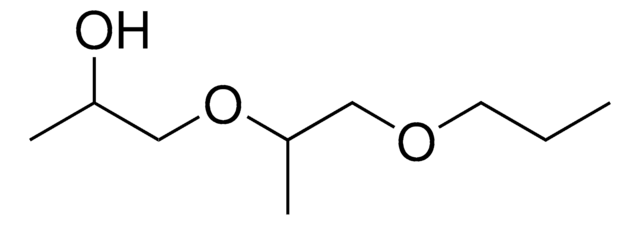256366
2-Butoxyethanol
spectrophotometric grade, ≥99.0%
Sinónimos:
2-Butoxyethanol, Butyl glycol
About This Item
Productos recomendados
grade
spectrophotometric grade
Quality Level
vapor density
4.1 (vs air)
vapor pressure
<1 mmHg ( 20 °C)
10 mmHg ( 81 °C)
assay
≥99.0%
form
liquid
autoignition temp.
473 °F
expl. lim.
10.6 %
technique(s)
UV/Vis spectroscopy: suitable
impurities
≤0.1% water
evapn. residue
<0.001%
refractive index
n20/D 1.419 (lit.)
bp
169-172.5 °C (lit.)
mp
−75 °C (lit.)
density
0.902 g/mL at 25 °C (lit.)
λ
H2O reference
UV absorption
λ: 230 nm Amax: 1.0
λ: 250 nm Amax: 0.10
λ: 275 nm Amax: 0.05
λ: 300-400 nm Amax: 0.01
SMILES string
CCCCOCCO
InChI
1S/C6H14O2/c1-2-3-5-8-6-4-7/h7H,2-6H2,1H3
InChI key
POAOYUHQDCAZBD-UHFFFAOYSA-N
¿Está buscando productos similares? Visita Guía de comparación de productos
Categorías relacionadas
General description
Application
signalword
Danger
Hazard Classifications
Acute Tox. 3 Inhalation - Acute Tox. 4 Oral - Eye Irrit. 2 - Skin Irrit. 2
Storage Class
6.1C - Combustible, acute toxic Cat.3 / toxic compounds or compounds which causing chronic effects
wgk_germany
WGK 1
flash_point_f
152.6 °F - Pensky-Martens closed cup
flash_point_c
67 °C - Pensky-Martens closed cup
Certificados de análisis (COA)
Busque Certificados de análisis (COA) introduciendo el número de lote del producto. Los números de lote se encuentran en la etiqueta del producto después de las palabras «Lot» o «Batch»
¿Ya tiene este producto?
Encuentre la documentación para los productos que ha comprado recientemente en la Biblioteca de documentos.
Los clientes también vieron
Nuestro equipo de científicos tiene experiencia en todas las áreas de investigación: Ciencias de la vida, Ciencia de los materiales, Síntesis química, Cromatografía, Analítica y muchas otras.
Póngase en contacto con el Servicio técnico









